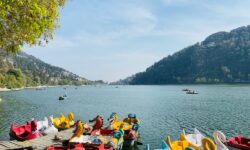Rajasthan Tourism: A Complete Guide for Real Cultural Seekers
Rajasthan Tourism is not just about palaces and deserts—it’s an entire experience stitched together with stories, traditions, colors, and people. Every corner of this state holds something that connects you to history, craftsmanship, food, and old-world charm. This guide gives you a detailed view of what Rajasthan Tourism truly feels like, beyond what glossy brochures tell you.
What Makes Rajasthan Tourism So Unique?
Rajasthan Tourism is not built around just one element—it’s a blend of heritage, hospitality, and handmade beauty. From the sounds of folk music in the air to forts that whisper centuries of untold tales, this state offers more than just sightseeing. It’s about how each city lives its own version of tradition while welcoming outsiders like family.
You’re not stepping into a tourist zone—you’re stepping into a place where history is still alive. Even the smallest shopkeeper in a narrow Jaipur lane might talk about the Mughal era or Rajput stories with ease. This depth is why Rajasthan Tourism feels personal, memorable, and real.
Jaipur: A City Where Old Meets New, Naturally
Jaipur, the capital city, is often the starting point of Rajasthan Tourism. But calling it just the “Pink City” wouldn’t be fair. The city holds centuries-old forts like Amer, but also buzzing markets where handcrafted jewelry and block-printed fabrics take center stage.
The vibe is never too pushy. People invite you into their stories. A rickshaw ride here is not just transport—it’s an experience where drivers often become your unofficial guide. You’ll hear tales that didn’t make it to history books but make perfect sense in the lanes of Jaipur.
Don’t miss:
- City Palace: Still home to the royal family.
- Hawa Mahal: A honeycomb of windows built for royal women.
- Johari Bazaar: If handmade silver or gemstones excite you, spend hours here.
Jodhpur: Blue Walls, Big Forts, and Honest Smiles
Jodhpur is often called the Blue City, but it’s not just a name. The old town is actually painted in shades of blue. For Rajasthan Tourism, Jodhpur holds a strong cultural presence with a dose of simplicity. This city isn’t trying to impress—it simply is.
Mehrangarh Fort dominates the skyline and tells stories without any dramatic effects. It stands solid, almost like a quiet elder in the family. You can spend hours just walking through the fort, listening to wind whistling through its walls.
What to see:
- Mehrangarh Fort: Arguably one of the best-preserved forts in India.
- Clock Tower Market: Authentic, vibrant, and local.
- Stepwells (Toorji ka Jhalra): Not crowded, still connected to local life.
Udaipur: More Than Just Lakes and Palaces
Many associate Rajasthan Tourism with Udaipur’s dreamy lakes and palaces. But there’s more under the surface. Udaipur’s charm lies in its peaceful rhythm. You’ll find morning prayers echoing across the lake, small art shops selling miniature paintings, and locals offering homemade food without any pretense.
Unlike many tourist-heavy cities, Udaipur doesn’t try to over-polish its face. It remains real and grounded. Walk the ghats at dawn, talk to local painters, or sip tea at a rooftop overlooking Lake Pichola—this city knows how to offer calm in a very real way.
Must-do in Udaipur:
- City Palace: A layered palace with centuries of craftsmanship.
- Bagore ki Haveli: Evening folk shows that feel truly local.
- Shilpgram: A crafts village with handmade works from across Rajasthan.
Jaisalmer: Life Inside the Sandstone Walls
When people talk about Rajasthan Tourism, they often picture deserts—and that’s where Jaisalmer comes in. But the golden city isn’t just about dunes. It’s a living fort city where families still reside inside the walls of Jaisalmer Fort.
There’s something raw and touching about walking into homes that have existed for generations. Every stone, every carving has a human touch. Add to that the experience of eating dal baati churma on a rooftop with camels walking in the distance—it’s something you won’t forget.
Things worth your time:
- Jaisalmer Fort: A living fort that breathes history.
- Sam Sand Dunes: For a quiet sunset, not just camel rides.
- Havelis (like Patwon Ki Haveli): Craftsmanship that speaks of lost skills.
Bikaner and Bundi: Quiet Yet Powerful
Rajasthan Tourism isn’t only about famous cities. Smaller towns like Bikaner and Bundi hold stories that remain under the radar but are deeply authentic. Bikaner’s Junagarh Fort is a marvel of Rajput architecture. Bundi, on the other hand, feels like a city paused in time—with blue houses, stepwells, and murals that haven’t been touched up for Instagram.
These places are perfect for those who want to avoid big crowds and still get the full cultural experience. Locals welcome with less fanfare and more warmth. These cities reflect a slower, deeper Rajasthan.
What to explore:
- Bundi Palace: With wall paintings that remain untouched.
- Junagarh Fort in Bikaner: No hill, but still majestic.
- Bhandasar Jain Temple: Pure marble art meets calm spirituality.
Food in Rajasthan Tourism: Simple, Strong, and Local
Food in Rajasthan is not built for the gram—it’s built for real hunger, real taste. Each region offers its own take, often dictated by history and local resources. You’ll find dishes like:
- Dal Baati Churma: A plate with baked wheat balls, spicy dal, and sweet churma.
- Laal Maas: A red meat curry with intense flavor, often spicy.
- Ker Sangri: A dry dish made from local desert beans—only found here.
Even snacks like kachoris, mirchi vada, and ghevar are part of the daily rhythm. What makes it special? It’s all handmade, often by people who don’t call themselves chefs but have learned from generations before them.
Rajasthan Tourism Through Local Hands
Craftsmanship is a big part of Rajasthan Tourism. But it’s not about shops pushing tourists to buy. It’s about artisans who still work in the same lanes where their grandparents did. You’ll see:
- Blue Pottery in Jaipur
- Miniature Painting in Udaipur
- Mojari (traditional leather shoes) in Jodhpur
- Hand-embroidered textiles in Barmer
You’re not just buying an item—you’re meeting the maker, hearing their story, and taking a piece of it home.
When to Travel and How to Plan
Rajasthan Tourism sees peak travel from October to March when the weather supports walking and exploring. Summer months can be harsh but are quieter if you’re looking for less crowd.
Public transport is decent between major cities, but hiring a local cab or driver often makes more sense when you want flexibility. Homestays are growing in popularity and add a warm touch to your stay, often more memorable than luxury hotels.
Rajasthan Tourism Is About People, Not Just Places
If there’s one core to Rajasthan Tourism, it’s the people. From the camel herder in the Thar to the handloom weaver in a small village, you’ll meet humans who’ve kept stories alive not through books but through actions, rituals, and work.
They might not speak fluent English, but their warmth doesn’t need translation. This human connection is what will stay with you long after the forts and fabrics fade from memory.
Final Thoughts on Rajasthan Tourism
Rajasthan Tourism is not a checklist of monuments—it’s a cultural memory that lingers. You’ll return not just with photos but with real stories. It’s not about luxury, not about show—it’s about heritage, humanity, and how those two still live side by side.
Whether you’re someone looking for rooted traditions, handmade crafts, honest food, or just a deeper connection with a place that knows its past well, Rajasthan Tourism welcomes you without changing itself.
It’s a place that teaches you to slow down, listen more, and value the old as much as the new. And that’s rare in today’s world.








